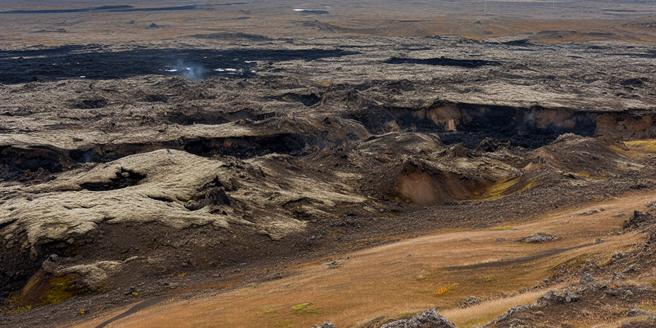
Understanding the Climate of Medieval Iceland
In the medieval era, Iceland’s climatic conditions were more favorable than now, with milder weather thanks to warm water currents from the Gulf Stream. This created an appealing environment that attracted settlers and explorers. However, despite these conditions, the island’s geological activity presented challenges. The plentiful volcanic activity led to periodic eruptions that significantly changed the climate as the ash and gas could block sunlight, resulting in abrupt temperature drops. These unexpected harsh winters caused agricultural difficulties as fields, adapted to temperate weather, suddenly faced extreme conditions. These changes led to crop failures and food scarcity, making life challenging for settlers. Thus, while the warm sea currents maintained relatively mild winters and cool summers, making the land attractive, the unpredictable volcanic activities threatened to destabilize the climate, leading to drastic reductions in temperature, abrupt winters, and consequent agricultural challenges.
The Importance of Weather in Viking Exploration
The weather conditions of their era heavily influenced the explorations and settlements of the Vikings. Desirable meteorological patterns, characterized by advantageous winds and ocean currents, steered the Vikings’ longships across the vast North Atlantic to places like Iceland. This allowed them to greatly expand their territories, with their discovery of Iceland charting a significant course in their history.
The land played a crucial role in shaping Viking culture, such as the volcanic soils of Iceland that created rich grasslands perfect for livestock farming. The moderate temperatures kept these grasslands lush, providing an ample source of food and resources for the Vikings to survive. It also allowed them to maintain steady settlements in such a harsh environment. Therefore, the Viking way of life was largely shaped by the combination of weather conditions, land characteristics, and their ability to adapt to these elements.
How Harsh Winters Shaped Settlement Patterns in Iceland
Severe winter conditions defined settlement patterns in medieval Iceland. Norse explorers, known as Vikings, strategically selected locations offering protection against the harsh weather. Their choices involved sheltered valleys that provided natural fortresses against the biting cold while providing fertile farming lands and fresh water resources. They also sought thermal hot spring areas, which provided heat during winters and served as communal gathering spots. Coastal regions were favored for their abundant marine supplies and strategic advantage for the seafaring Vikings. This strategic approach to settlement, leveraging Iceland’s diverse geology, illustrated human resilience and innovative adaptation to the harsh weather conditions.
Agriculture and the Role of Climate in Iceland’s Growth
The Viking settlers, originating from the Scandinavian vicinity, bravely adapted to the challenging weather conditions they found in their new home of Iceland. Despite the inhospitable climate, these early settlers crafted innovative methods to thrive and create a sustainable agriculture system. They turned the harshness of their new environment into an opportunity by cultivating barley and keeping a variety of livestock despite the tough growing conditions, thus ensuring their survival and paving the way for modern Iceland’s societal development. Their success story serves as indisputable proof that understanding and effective utilization of climatic conditions can foster socio-economic growth and improved living standards. Indeed, their innovative agricultural model and the economic prosperity it fostered remain a cornerstone of Iceland’s history, exemplifying how survival instincts, adaptability and resourcefulness can allow civilization to flourish even under the toughest conditions.
Weather Impact on Iceland’s Cultural Evolution
Iceland’s unpredictable weather, known for harsh winters and brief summers, has greatly shaped its cultural evolution by fostering resilience and endurance. This was not only through the challenges of the climate but also the opportunities it presented for spiritual and imaginative expressions. A prominent example of this is the awe-inspiring Northern Lights, inspiring myths, folklores and a deep appreciation of nature. It’s fair to say that the nation’s climate has been central in defining the essence of being Icelandic, showcasing how an extreme environment can cultivate both resilience and cultural richness.
Climate Change: Past, Present, and Future Impacts on Iceland’s Settlement
Climate change has significantly shaped Iceland’s evolution and settlements over time. The dramatic shifts in the past effectively facilitated the arrival of settlers, paving the way for colonization, with communities gradually learning to adapt to the island’s climatic oscillations. Today, we are witnessing an acceleration in global warming; a modern climate change phenomenon that could predict a future of new challenges and opportunities. These adaptations to the changing environment involve unpredictable weather, shifting ecosystems, and, simultaneously, presenting interesting prospects for inhabitants. Now, the relationship between Iceland’s communities and their surroundings becomes critical, requiring a dynamic balance between human needs and environmental stewardship. The profound effects of climate change on Iceland’s settlement aren’t just a historical phenomenon. The island continues to face a future of global warming, novel challenges, and unprecedented opportunities, rooted in the deep connection between its communities and their environment.
